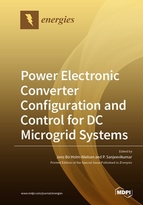Power Electronic Converter Configuration and Control for DC Microgrid Systems
A special issue of Energies (ISSN 1996-1073). This special issue belongs to the section "A1: Smart Grids and Microgrids".
Deadline for manuscript submissions: closed (31 March 2020) | Viewed by 47022
Special Issue Editors
Interests: renewable energy systems; smart energy systems; biomass resources; biogas production; bio-refineries
Special Issues, Collections and Topics in MDPI journals
Interests: power electronics; electrical drives; renewable energy; power electronics converter; modulation techniques; grid connected system
Special Issues, Collections and Topics in MDPI journals
Special Issue Information
Dear Colleagues,
The microgrid system has been continuously gaining attention over the last decade in both academia and industry. The microgrid system is a key empowering technology to integrate various types of renewable energy sources (RES) accompanied with a smart control approach in order to enhance the system reliability and efficiency. With the help of a power electronics converter, a microgrid provides a higher flexibility, and an easier management over RES, electronics load, and energy storage systems. The performance of the microgrid can be efficiently governed by properly choosing the power electronic interface. With the rapid emergence of power electronics, the importance of microgrids in today’s society is gradually being brought to a whole new level.
The aim of this Special Issue is to broadcast the recent technological progression towards the modelling and design of power converter topologies and their controllers, in order to improve the performance of a microgrid system.
Topic of interest includes, but are not limited to, the following:
- Modelling and design of high voltage gain DC–DC power converters for microgrid applications.
- Multilevel converter for PV integrated microgrid applications.
- Bidirectional converter for an electric vehicular system.
- Multistage DC–DC converter with voltage boosting techniques.
- Multiport DC–DC converter for microgrid application.
- Advance the control and modulation strategies to improve the dynamic performance of power electronics converters.
- Control strategies for grid interfacing converters.
Prof. Dr. Jens Bo Holm-Nielsen
Dr. Sanjeevikumar Padmanaban
Guest Editors
Manuscript Submission Information
Manuscripts should be submitted online at www.mdpi.com by registering and logging in to this website. Once you are registered, click here to go to the submission form. Manuscripts can be submitted until the deadline. All submissions that pass pre-check are peer-reviewed. Accepted papers will be published continuously in the journal (as soon as accepted) and will be listed together on the special issue website. Research articles, review articles as well as short communications are invited. For planned papers, a title and short abstract (about 100 words) can be sent to the Editorial Office for announcement on this website.
Submitted manuscripts should not have been published previously, nor be under consideration for publication elsewhere (except conference proceedings papers). All manuscripts are thoroughly refereed through a single-blind peer-review process. A guide for authors and other relevant information for submission of manuscripts is available on the Instructions for Authors page. Energies is an international peer-reviewed open access semimonthly journal published by MDPI.
Please visit the Instructions for Authors page before submitting a manuscript. The Article Processing Charge (APC) for publication in this open access journal is 2600 CHF (Swiss Francs). Submitted papers should be well formatted and use good English. Authors may use MDPI's English editing service prior to publication or during author revisions.
Keywords
- power electronics
- renewable energy
- grid integration
- pv systems
- power quality







